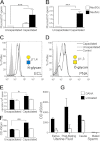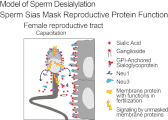Sialidases on mammalian sperm mediate deciduous sialylation during capacitation
- PMID: 22989879
- PMCID: PMC3488077
- DOI: 10.1074/jbc.M112.380584
Sialidases on mammalian sperm mediate deciduous sialylation during capacitation
Abstract
Sialic acids (Sias) mediate many biological functions, including molecular recognition during development, immune response, and fertilization. A Sia-rich glycocalyx coats the surface of sperm, allowing them to survive as allogeneic cells in the female reproductive tract despite female immunity. During capacitation, sperm lose a fraction of their Sias. We quantified shed Sia monosaccharides released from capacitated sperm and measured sperm sialidase activity. We report the presence of two sialidases (neuraminidases Neu1 and Neu3) on mammalian sperm. These are themselves shed from sperm during capacitation. Inhibiting sialidase activity interferes with sperm binding to the zona pellucida of the ovum. A survey of human sperm samples for the presence of sialidases NEU1 and NEU3 identified a lack of one or both sialidases in sperm of some male idiopathic infertility cases. The results contribute new insights into the dynamic remodeling of the sperm glycocalyx prior to fertilization.
Figures





References
-
- Varki A., Schauer R. (2009) Essentials of Glycobiology, pp. 199–218, Cold Spring Harbor Press, Plainview, NY - PubMed
-
- Schröter S., Osterhoff C., McArdle W., Ivell R. (1999) The glycocalyx of the sperm surface. Hum. Reprod. Update 5, 302–313 - PubMed
-
- Schauer R. (1982) Chemistry, metabolism, and biological functions of sialic acids. Adv. Carbohydr. Chem. Biochem. 40, 131–234 - PubMed
-
- Schauer R. (2004) Sialic acids: fascinating sugars in higher animals and man. Zoology 107, 49–64 - PubMed
-
- Bernal A., Torres J., Reyes A., Rosado A. (1980) Presence and regional distribution of sialyltransferase in the epididymis of the rat. Biol. Reprod. 23, 290–293 - PubMed
Publication types
MeSH terms
Substances
Grants and funding
LinkOut - more resources
Full Text Sources
Other Literature Sources

